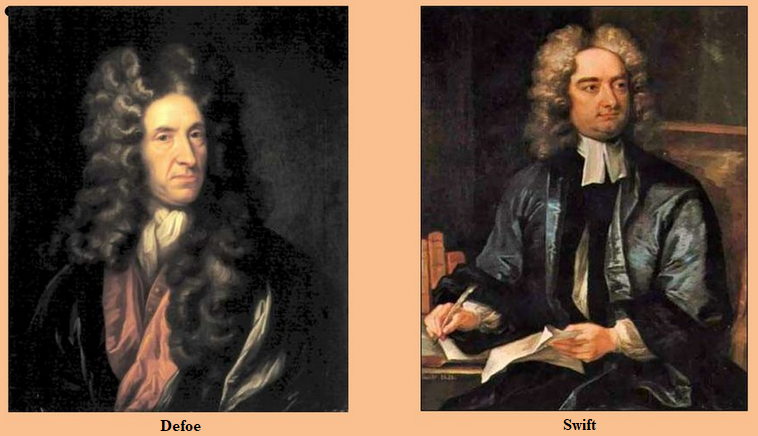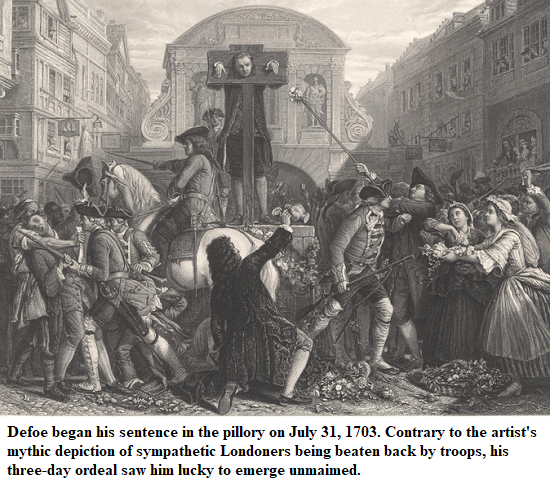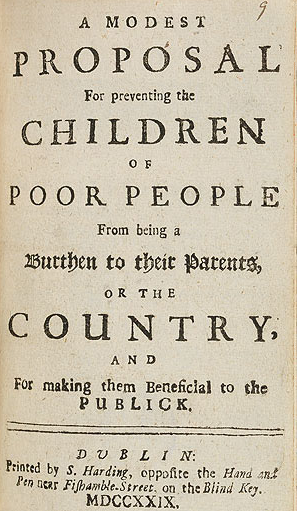
The future Dean of St Patrick’s Cathedral, Dublin—Jonathan Swift—has a character in one of his many pamphlets dismiss Daniel Defoe as “the Fellow that was pilloried (I have forgot his name)”. Further on however, if not by name, Defoe is described as being “so grave, sententious, dogmatical a rogue that there is no enduring him”. The critic is a fictional Irish bishop in a piece that Swift wrote supporting the so-called Test Act in 1709—“An act for preventing dangers which may happen from popish recusants.”
The said Act required all holders of both civil and military office to receive communion in the Church of England at least once per annum and take the following oath:
I do solemnly and sincerely, in the presence of God, profess, testify and declare that I do believe in the sacrament of the Lord’s Supper: there is not any transubstantiation of the elements of bread and wine into the body and blood of Christ, at or after the consecration thereof by any person whatsoever; and that the invocation or adoration of the Virgin Mary, or any other saint, and the sacrifice of the Mass, as they are now used in the Church of Rome, are superstitious and idolatrous.
Defoe was not a Catholic, rather, a prominent Presbyterian Dissenter and he had stirred the pot some seven years earlier with an anonymously written pamphlet of his own. The Shortest Way with Dissenters (1702) mocked High Church diatribes against those considered “the schismatic mob” and so effectively did it parrot the style of such prominent sermonisers as Henry Sacheverell, that initially at least, it had been taken for the real thing. After a time, shrewder readers began to smell a rat and a groundswell of opinion soon accepted that the wider public had been hoaxed.
This essay appeared in a recent Quadrant.
Subscribers enjoyed it months ago
The pamphlet, while just stopping short of advocating the complete annihilation of the dissenting rabble, proposed a shaking down so severe as to make the bulk of those who may have strayed from the right path see the errors of their ways. Defoe’s sermoniser argued that a succession of monarchs, beginning with James I, has been too lenient with Dissenters:
Truly the worst they suffered was, at their own request, to let them go to New England, and erect a new colony, and give them great privileges … and (in return) receive no taxes or revenue …
With ever increasing Juvenalian invective and zeal, it is put that instead, these puritans should have all been shoved off to the West Indies; for by the reign of William III, it was apparent they had, “crope [crept] into all places of Trust and Profit” and “engrossed the ministry”. Any counter-argument that Dissenters should be granted toleration based purely on their sheer weight of numbers is answered sneeringly by the observation that the French had been awash with Protestants and yet its king had rightly seen fit, without ceremony, to kick them out. Surely the high numbers of “the viperous brood that have so long sucked the blood of the mother” made them all the more dangerous and demonstrated that their suppression was even more warranted. Moses is cited. Though by nature merciful and meek, he had still deemed it necessary to massacre the 33,000 Israelites who had “fallen into idolatry”. Moses had rightfully made an example of them for the greater good and it stood to reason that a similar course of action befitted the Dissenters. If enough were banished to an unsavoury place and their preachers hanged—after all, other men were hanged “for trifles” and sent from England “for things not worth naming”—many of the wiser renegades would realise their own folly and relent. The time was ripe to eradicate this “Weed of Sedition that has so long disturbed the Peace of the Church and poisoned the good corn”, since the realm—now under Anne—had the “protection of a True Church of England Queen”. The pamphlet closes with the catchcry, “Now, let us crucify the thieves!” and asks, why should the Papist with his worship of Seven Sacraments be seen in a worse light than the Quaker, who acknowledges none?
Throughout, Queen Anne is generally lauded, but the idea that she should receive unsolicited advice regarding her position as head of church and state and in such a manner did not sit well. Her government was angered also. One of the pamphlet’s effects was to damage the prospects of a Parliamentary Bill to outlaw what had become known as Occasional Conformity. The purpose of the Bill was to eliminate the idea that one need only attend one Anglican service per annum. Such scant regard for the Church of England by Catholics and Dissenters would no longer be tolerated. This was by no means a trivial matter, since holding any form of public office, civil or military, required allegiance to the mother church, as did admittance to both Oxford and Cambridge universities.
When it became known that Daniel Defoe had written the piece, a reward of £50 was offered for his apprehension. He was accused of having written a “scandalous and seditious” pamphlet and described as:
middle-sized … about forty … of a brown complexion and dark brown coloured hair [with] a wig, a hooked nose, a sharp chin, grey eyes, and a large mould [mole] near his mouth … born in London, and [was] for many years a hose factor in Freeman’s-yard, in Corn-hill, and now is owner of the brick and pantile works near Tilbury-fort in Essex.
Defoe may have spent some time in Holland, but for the most part, it seems his time as a fugitive was spent hiding in the households of Whig supporters. In the meantime, the pamphlet had been ceremoniously burned by the common hangman in New Palace Yard. He was eventually arrested in the house of a Huguenot weaver who, having been forced from France, had set up shop at Spitalfields in the East End. Defoe was incarcerated from May to November of 1703 and ordered to stand in the pillory on three occasions in July. In the short term, he would be financially ruined. The extra punishment was designed to provide a lifelong humiliation.
He had been imprisoned before. Unpaid debts accrued by failed business schemes had been his undoing; a machine for extracting treasure from shipwrecks had flopped, as had a farm that would produce perfume from civets. It was fair to surmise that Defoe had led a life best described as indefatigable. To be pilloried was not only extremely unpleasant but downright dangerous; hurled stones or bits of brick, rather that the more popular rotten vegetable matter or animal excrement, could kill. It is most likely that the story of Defoe’s popularity having saved him from such behaviour is urban myth. The weather records for that July indicate a month unseasonably wet and it is perhaps no coincidence that Defoe maintains in Robinson Crusoe (1719), that the July rains are the most dangerous.

This pamphlet saga was newsworthy enough for Swift’s Irish bishop’s slippage with regards to Defoe’s name to be seen as, if not churlish, then at the very least, feigned. No doubt it was an intended slight on Defoe by Swift himself; after all, the Anglo-Irishman and Defoe were unquestionably rivals. As with most literary rivalries, the work of the two men shares more similarities than differences, and as Thomas Mann was to put it so succinctly many years later with reference to Herman Hesse: “It is always unpleasant to be reminded that one is not alone in the world.”
Defoe’s and Swift’s most-read books, Robinson Crusoe and Gulliver’s Travels respectively (the latter completed seven years after the former in 1726), are noted for adopting the pose of quasi-autobiography. Initially, both had supposedly been written by their respective protagonists: Crusoe and Lemuel Gulliver. Stylistically both works are considered “realist” and decidedly un-Augustan. Many readers of Robinson Crusoe have believed the story true, helped along no doubt by the author’s preface which somewhat equivocally states: “The editor believes the thing to be a just history of fact; neither is there any appearance of fiction in it.”
More surprising is the number of readers who have taken Lemuel Gulliver at his word. Here we deal with the existence of a people less than six inches tall, or farmers seventy-two feet in height, not to mention flying islands and talking horses. Swift wryly had his own “publisher” avow: “There is an air of truth apparent through the whole …”
Yet he must have been astounded to hear of the sea captain who reportedly claimed to have known Gulliver, adding that the printer of the book had erred somehow, since it was a well-known fact that he had lived in Wapping, not Rotherhithe. And while an Irish bishop also famously declared that he could believe barely a word of Swift’s book and felt much of it must be made up, many other readers had scuttled off to their library atlases searching for the island of Lilliput, which apparently lay in the southern straits below Sumatra and Java. If readers of the two novels mistook fiction for travelogue and memoir then so be it: sales soared.
Two years after the publication of Gulliver’s Travels, Swift wrote another pamphlet, A Modest Proposal for Preventing the Children of Poor People from Being a Burden to Their Parents or Country, and for Making Them Beneficial to the Public (1729). It is possibly a direct response to Defoe’s more sombre undertaking, The Generous Projector or, A Friendly Proposal to Prevent Murder and Other Enormous Abuses, by Erecting an Hospital for Foundlings and Bastard Children (1728), but it is here that Swift took the reading public’s potential for gullibility to an extreme.
In Ireland, extremely slim harvest yields in the 1720s and the brutally harsh winter of 1728-29 had created what was effectively a widespread famine. Swift had already published commentaries on the plight of the impoverished of Ireland only to be met with silence and a sense of hopelessness, but this time his clear intention was to shock.
His introduction adopts a tone which readers of such pamphlets would have immediately found familiar: an earnestness which professes a concern for the living conditions of the poor. Beginning with a mandatory discussion of the distress of beggar women and concern for their infants, Swift lures the reader to continue on by an assurance that, after much cogitation, he has arrived at “an easy method of making these children sound and useful members of the commonwealth”. His plan, he is pleased to say, would rid the commonwealth of the disturbing increase in voluntary abortions as well as the heinous practice of infanticide.
 Every first-time reader is taken aback by his radical proposal:
Every first-time reader is taken aback by his radical proposal:
I have been assured by a very knowing American of my acquaintance in London that a young healthy child, well nursed, is at a year old, a most delicious, nourishing, and wholesome food, whether stewed, roasted, baked, or boiled; and I make no doubt that it will equally serve in a fricassee or a ragout … A child will make two dishes at an entertainment for friends, and when the family dines alone, the fore or hind quarter will make a reasonable dish, and seasoned with a little pepper or salt, will be very good boiled on the fourth day, especially in winter.
Swift goes on to calculate a cost of two shillings for a parent to maintain a child (rags included) until it reaches the age of “one solar year”. At this point it would be, as it were, ready for market (having reached an estimated weight of twenty-four pounds). Consequently, an asking price of ten shillings would, in Swift’s opinion, seem fair. This would give the mother eight shillings on which to survive—a euphemism for keeping fit enough for work—and tiding her over for the duration of her next pregnancy and the birth of her next child.
He suggests the children should be purchased alive, and dressed “hot from the knife, as we do roasting pigs”. As an afterthought, he feels that the skins of the children, “artificially dressed”, might make “admirable gloves for ladies and summer boots for fine gentlemen”. Swift explains that given Ireland’s dwindling stocks of game deer he has considered the idea of the consumption of older children, however his advisers reliably inform that it is most likely the meat would be too tough.
The pamphlet insinuates, of course (“I could name a country which would be glad enough to eat up our whole nation”), that England, already gourmandising on Ireland, may as well tuck into its future as well. And wearing an ironic mask of hard economics, amoral utilitarianism and social engineering—all hot topics in the early eighteenth century—and applying the vocabulary of animal husbandry (“breeders”, “yearling child”, “when a child is dropped from its dam”), Swift cleverly reduces people to meat, then to value by weight and then to sustainable profit. He calculates that of the 120,000 Irish children born per annum, one sixth of these needs be held back for breeding purposes, liberally suggesting one quarter of these should be male—a higher ratio, he points out, than that applied to the farming of sheep, cattle and swine. By now, the pamphlet’s intention is clear, its searing satire laying bare hypocrisy and inhumanity.
However, we live in a harsh world. The work achieved little for Ireland’s poor. While satire succeeds in highlighting situations, it struggles to solve them. Yet the genius of Swift’s irony was well noted. Whether the sea captain who knew Gulliver, or the Irish bishop who questioned Swift’s facts regarding him, ever made attempts to subscribe towards such a scheme is not known, however the prominent Tory, Lord Bathurst, writing from England, responded to Swift, tongue firmly planted in cheek:
I did immediately propose it to Lady Bathurst … particularly for her last boy, which was born the plumpest, finest thing, that could be seen; but she fell in a passion, and bid me send you word, that she would not follow your direction, but that she would breed him up to be a parson and he should live upon the fat of the land; or a lawyer, and then, instead of being eat himself, he should devour others.
He adds: “it appears to me … it ought by no means to be confined to Ireland; for in all probability, we shall, in a very little time, be altogether as poor here as you are there”.
Barry Gillard lives in Geelong. He wrote on Philip Larkin in the May issue
 Sign In
Sign In 0 Items (
0 Items ( Search
Search









Good piece , good writing, plenty of research, enjoyable to read. They were both original and brilliant in my view, but I’d give the prize for satire to Swift and for the novel to Defoe. Dr.Johnson thought Swift was a bit overrated but of course he could always be disrespectful of anyone even approaching his own brilliance. On Swifts historical book ‘Conduct of the Allies’ he more or less said it wasn’t bad, as histories go, and was distinct enough ‘he had to count 10, and he has counted it right’ ; can’t find anything Johnson said about Defoe.